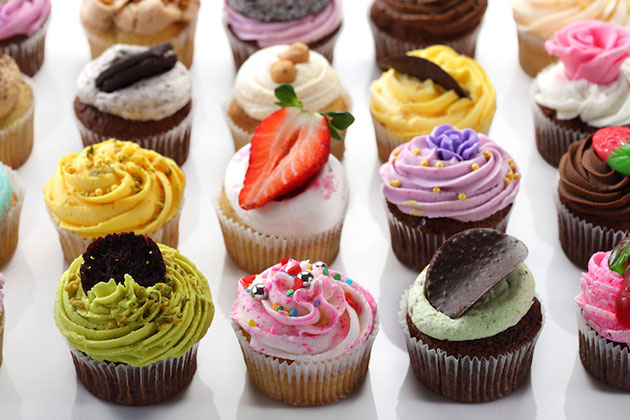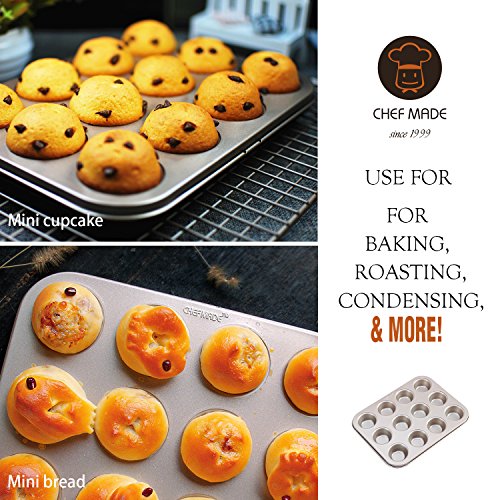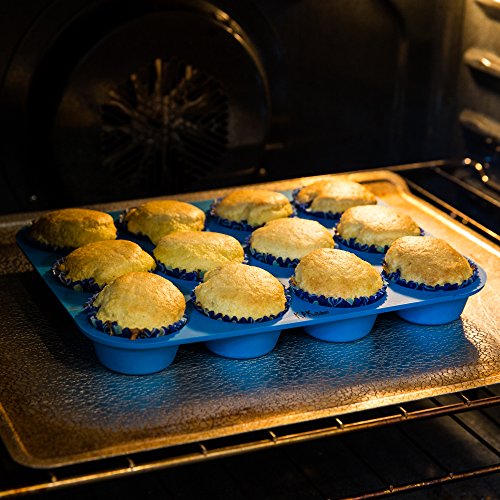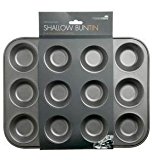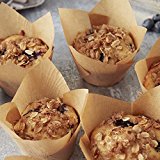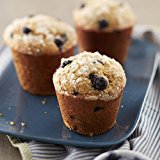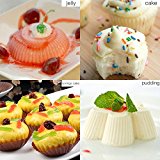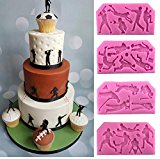The definition of the perfect cupcake is spongy, perfectly risen, with a moist, flaky crumb underneath a slightly sturdier crust.
Now that your mouth is watering let’s see how we achieve this result every time. The secret is using the best cupcake pans that don’t force the batter upwards. Instead, they allow the batter to rise gently, both upwards and outwards.
- Let's answer these questions to get a better understanding of cupcake pans
- What do you need to know about cupcake pans?
- Are the best cupcake pans metal or silicone?
- When should you choose silicone molds?
- What are bun tins?
- What are muffin tins?
- What are popover tins?
By the way, this post may contain Amazon affiliate links. This means that I receive a small commission, (at no extra cost to you) if you make a purchase through the links provided. Thank you for supporting Betty’s Bakeware.
5 points you should know about cupcake pans
1.Whether you’re cooking gourmet cupcakes to create a wedding cake tower, a Christening cake or little cakes for your child’s birthday party, the guidelines are the same for choosing pans.
2. It’s important to know how silicone and metal tins affect baking so you can make an informed choice for your style of cooking.
3. You need to understand the minor differences between cupcake tins, popover pans, muffin pans and bun tins to make sure that its a piece of cake to find the best cake pans for your cupcakes.
4. In the world of cake making there is no industry standard when it comes to cupcake tins, leaving both amateur and professional bakers wondering what the best cake pans for cupcakes are.
5. There are many types of cake tin out there that masquerade as cupcake tins. They look and feel similar and cost a similar amount, but they aren’t cupcake tins and will hamper your attempts to create the perfect little cupcake.
Cupcake tins differ in size, material, shape, and even angle, and choosing the right bakeware is the difference between a flop and producing the perfect spongy texture and moist crumb. There are ways to make the decision easier. It’s just about having more understanding about the types of tins and considering which type of material best meets your baking needs – metal or silicone.
In this summary we’ll go through what you can expect from baking tins and how to best use them in cooking. And most importantly you’ll learn which tins are not your best choices for cupcakes and why.
Are the best cupcake pans metal or silicone?
The better option depends on the type of cupcakes you’re making and, believe it or not, also depends on how confident you are in the kitchen.
Many cooks claim that silicone pans are the best because the rubber material is non-stick and it makes easy work of getting cakes out of the molds. While this is largely true, you have to consider the type of cupcakes you’ll be making.
Metal cake pans vs Silicone
- If you regularly make cupcakes with a high fat content, such as rich, buttery cupcakes, metal will suit you best. There could be too much oil left on the silicone, leaving your cupcakes with soggy bottoms and affecting the overall bake.
- Baking times will generally be longer with silicone than with metal. Rubber doesn’t conduct heat as well as metal. It’s more of an insulator. If you’re using an old family recipe you might have to alter cooking time slightly if using silicone. Many older recipes are written with metal cupcake tins in mind.
- If you’re the sort of baker who relies heavily on cooking guidelines, and who follows the recipe to the letter, the best cake pans for cupcakes are undoubtedly the metal variety.
Why choose silicone molds?
If you’re more of a confident, adventurous, and experimental cook, then keeping an eye on the cupcakes while they’re cooking in silicone molds should give you good results.
Versatility of silicone cake pans can’t be matched
The large range of different shapes and sizes available is where using silicone molds really excels.
Wanting to theme a party or event? As the molds can be used freezer to oven, use is limited only by your imagination.
Not only are silicone molds great for cupcakes, and breads, but you can also use them for preparing treats like homemade chocolates and desserts or shaped ice cubes.
The versatility doesn’t end there. Think of diy projects like soap making or extra special gifts.
Microwave, oven, refrigerator, freezer and dishwasher safe.
Safe for use in temperatures from -40°F to +450°F(-40℃ to +230℃).
Compelling reasons to consider these an essential addition to your kitchen.
A fun cooking project with children is getting them to help you make cakes in their favorite shapes. Whether they’re into dinosaurs, star wars or teddy bears. They’ll love the results and so will you.
What are bun tins?
On the surface, bun tins appear almost exactly like cupcake tins, but there is one significant difference, the depth of the wells.
Bun tins are not the best choice for cupcakes because they’re very shallow and designed to create small, bite-sized fairy cakes, rather than a more substantial cupcake. If you compare the two, you’ll notice that cupcake tins are much deeper, and are far more similar to a traditional muffin tin.
What are muffin tins?
Despite their likeness, muffin tins don’t make the best cake pans for cupcakes. It’s because there are some minor differences in the style and design of the pan that affect the cooking and aesthetics of a cupcake.
A muffin tin typically has straight sides which encourage the batter to rise upwards to form that classic muffin top, while cupcake tins have slightly flared edges to allow the batter to rise both upwards and outwards, producing the classic cupcake shape.
What are popover tins?
Popover tins are best described as a more exaggerated form of the classic muffin tin, with sharp, straight sides that force the batter upwards. Cupcake batter that is cooked in a popover tin is quite likely to burn at the top due to the intense rise, while remaining slightly undercooked in the middle.p
Silicone molds to bring your creative ideas to life
300 standard fluted paper, baking cups in bright colors


